Organisational Behaviour.
VerifiedAdded on 2023/01/05
|14
|4705
|26
AI Summary
Contribute Materials
Your contribution can guide someone’s learning journey. Share your
documents today.
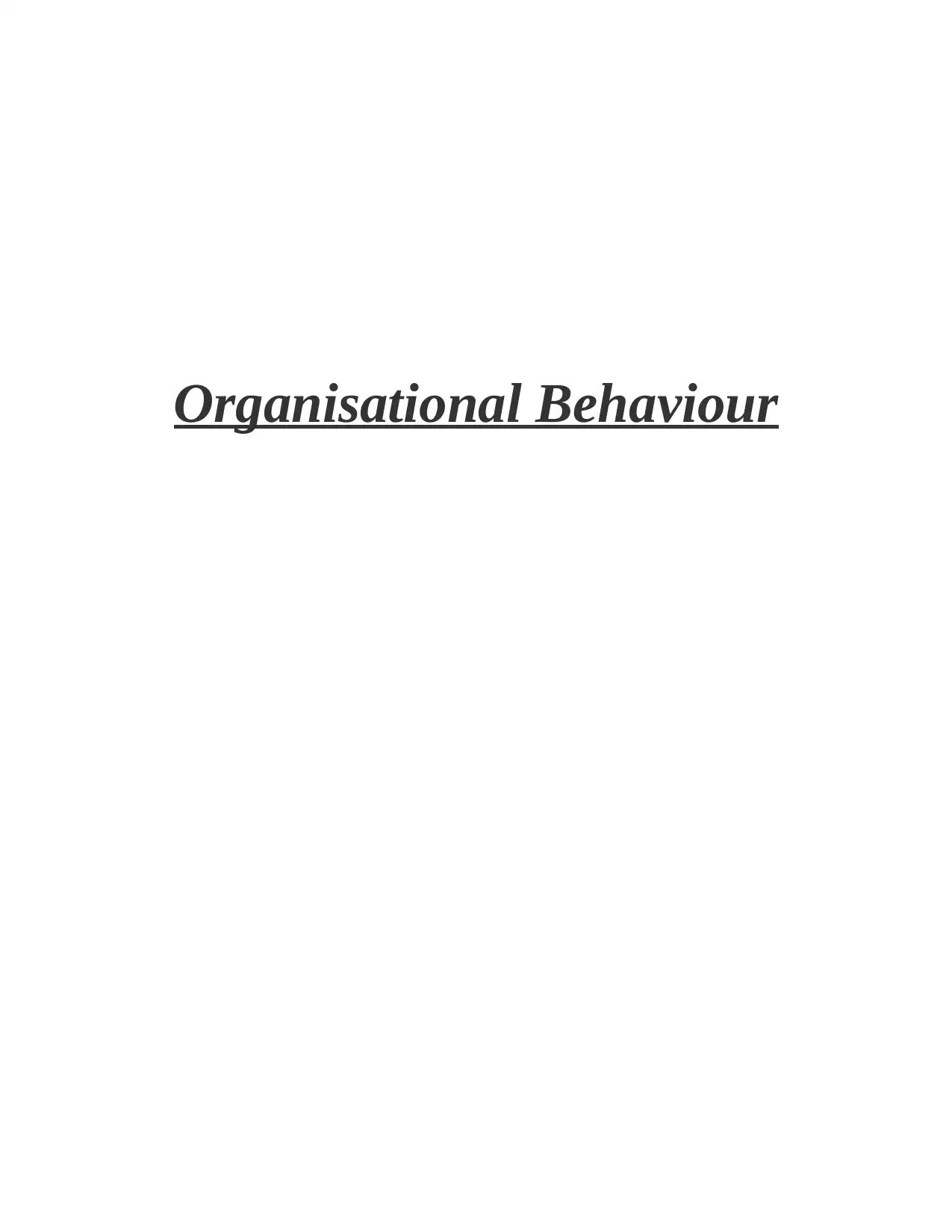
Organisational Behaviour
Secure Best Marks with AI Grader
Need help grading? Try our AI Grader for instant feedback on your assignments.
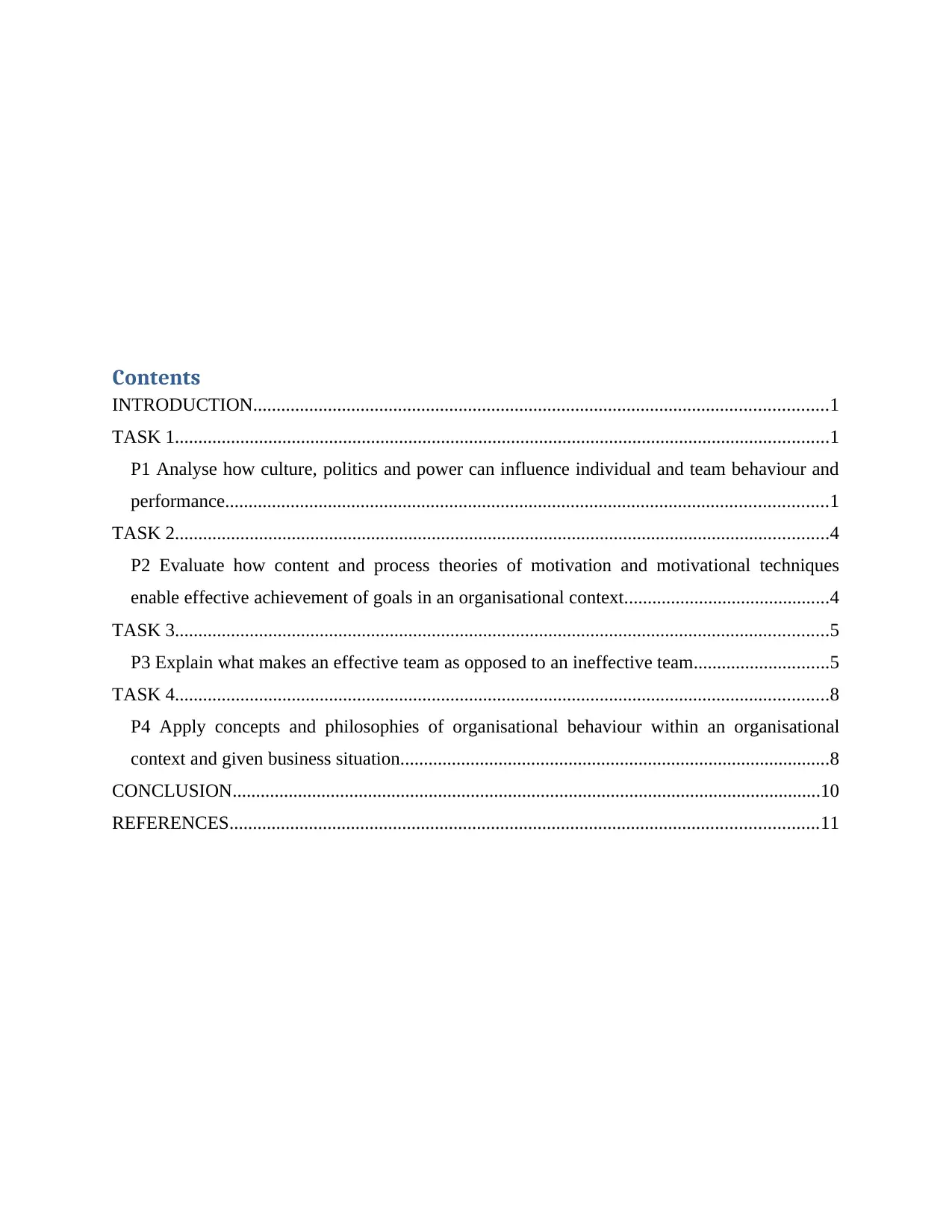
Contents
INTRODUCTION...........................................................................................................................1
TASK 1............................................................................................................................................1
P1 Analyse how culture, politics and power can influence individual and team behaviour and
performance.................................................................................................................................1
TASK 2............................................................................................................................................4
P2 Evaluate how content and process theories of motivation and motivational techniques
enable effective achievement of goals in an organisational context............................................4
TASK 3............................................................................................................................................5
P3 Explain what makes an effective team as opposed to an ineffective team.............................5
TASK 4............................................................................................................................................8
P4 Apply concepts and philosophies of organisational behaviour within an organisational
context and given business situation............................................................................................8
CONCLUSION..............................................................................................................................10
REFERENCES..............................................................................................................................11
INTRODUCTION...........................................................................................................................1
TASK 1............................................................................................................................................1
P1 Analyse how culture, politics and power can influence individual and team behaviour and
performance.................................................................................................................................1
TASK 2............................................................................................................................................4
P2 Evaluate how content and process theories of motivation and motivational techniques
enable effective achievement of goals in an organisational context............................................4
TASK 3............................................................................................................................................5
P3 Explain what makes an effective team as opposed to an ineffective team.............................5
TASK 4............................................................................................................................................8
P4 Apply concepts and philosophies of organisational behaviour within an organisational
context and given business situation............................................................................................8
CONCLUSION..............................................................................................................................10
REFERENCES..............................................................................................................................11
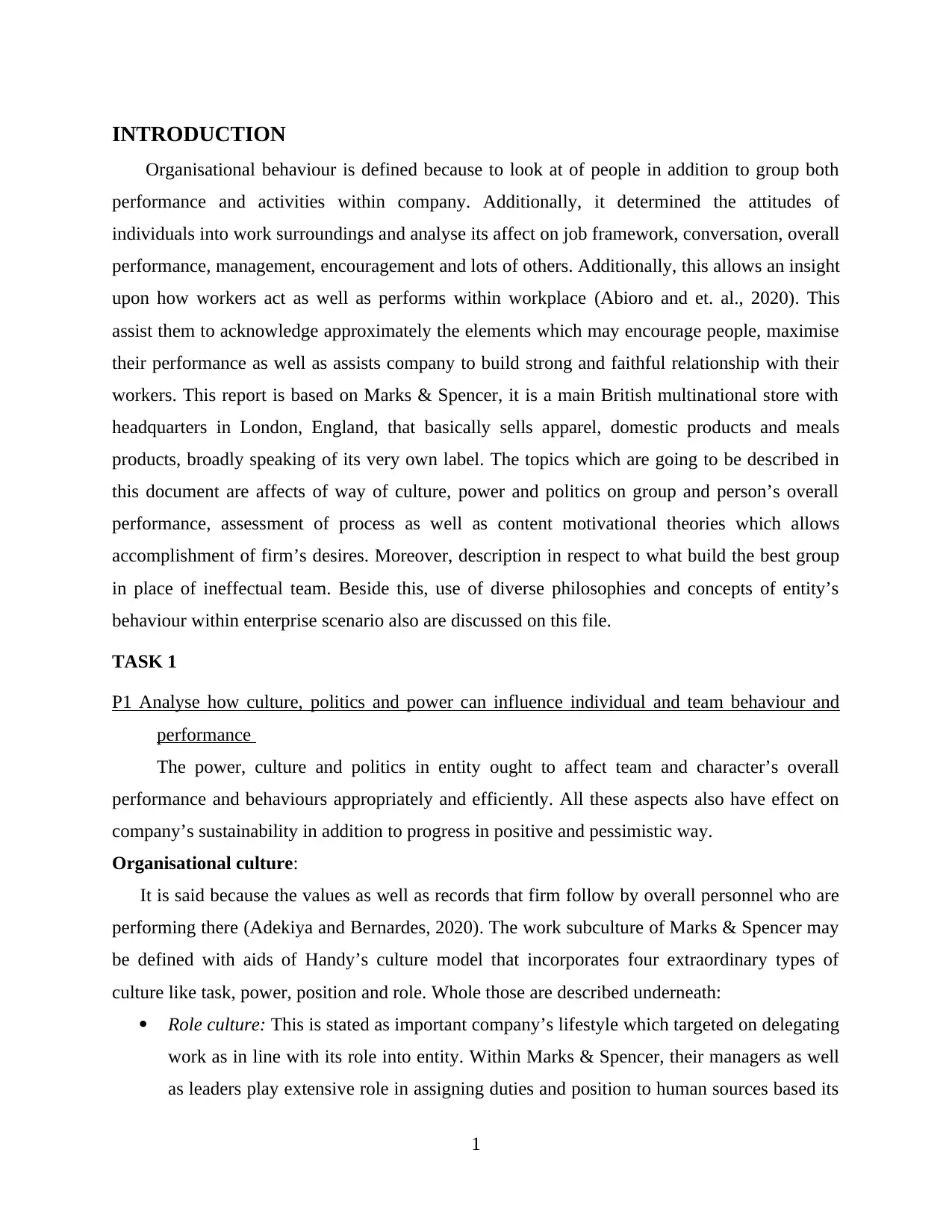
INTRODUCTION
Organisational behaviour is defined because to look at of people in addition to group both
performance and activities within company. Additionally, it determined the attitudes of
individuals into work surroundings and analyse its affect on job framework, conversation, overall
performance, management, encouragement and lots of others. Additionally, this allows an insight
upon how workers act as well as performs within workplace (Abioro and et. al., 2020). This
assist them to acknowledge approximately the elements which may encourage people, maximise
their performance as well as assists company to build strong and faithful relationship with their
workers. This report is based on Marks & Spencer, it is a main British multinational store with
headquarters in London, England, that basically sells apparel, domestic products and meals
products, broadly speaking of its very own label. The topics which are going to be described in
this document are affects of way of culture, power and politics on group and person’s overall
performance, assessment of process as well as content motivational theories which allows
accomplishment of firm’s desires. Moreover, description in respect to what build the best group
in place of ineffectual team. Beside this, use of diverse philosophies and concepts of entity’s
behaviour within enterprise scenario also are discussed on this file.
TASK 1
P1 Analyse how culture, politics and power can influence individual and team behaviour and
performance
The power, culture and politics in entity ought to affect team and character’s overall
performance and behaviours appropriately and efficiently. All these aspects also have effect on
company’s sustainability in addition to progress in positive and pessimistic way.
Organisational culture:
It is said because the values as well as records that firm follow by overall personnel who are
performing there (Adekiya and Bernardes, 2020). The work subculture of Marks & Spencer may
be defined with aids of Handy’s culture model that incorporates four extraordinary types of
culture like task, power, position and role. Whole those are described underneath:
Role culture: This is stated as important company’s lifestyle which targeted on delegating
work as in line with its role into entity. Within Marks & Spencer, their managers as well
as leaders play extensive role in assigning duties and position to human sources based its
1
Organisational behaviour is defined because to look at of people in addition to group both
performance and activities within company. Additionally, it determined the attitudes of
individuals into work surroundings and analyse its affect on job framework, conversation, overall
performance, management, encouragement and lots of others. Additionally, this allows an insight
upon how workers act as well as performs within workplace (Abioro and et. al., 2020). This
assist them to acknowledge approximately the elements which may encourage people, maximise
their performance as well as assists company to build strong and faithful relationship with their
workers. This report is based on Marks & Spencer, it is a main British multinational store with
headquarters in London, England, that basically sells apparel, domestic products and meals
products, broadly speaking of its very own label. The topics which are going to be described in
this document are affects of way of culture, power and politics on group and person’s overall
performance, assessment of process as well as content motivational theories which allows
accomplishment of firm’s desires. Moreover, description in respect to what build the best group
in place of ineffectual team. Beside this, use of diverse philosophies and concepts of entity’s
behaviour within enterprise scenario also are discussed on this file.
TASK 1
P1 Analyse how culture, politics and power can influence individual and team behaviour and
performance
The power, culture and politics in entity ought to affect team and character’s overall
performance and behaviours appropriately and efficiently. All these aspects also have effect on
company’s sustainability in addition to progress in positive and pessimistic way.
Organisational culture:
It is said because the values as well as records that firm follow by overall personnel who are
performing there (Adekiya and Bernardes, 2020). The work subculture of Marks & Spencer may
be defined with aids of Handy’s culture model that incorporates four extraordinary types of
culture like task, power, position and role. Whole those are described underneath:
Role culture: This is stated as important company’s lifestyle which targeted on delegating
work as in line with its role into entity. Within Marks & Spencer, their managers as well
as leaders play extensive role in assigning duties and position to human sources based its
1
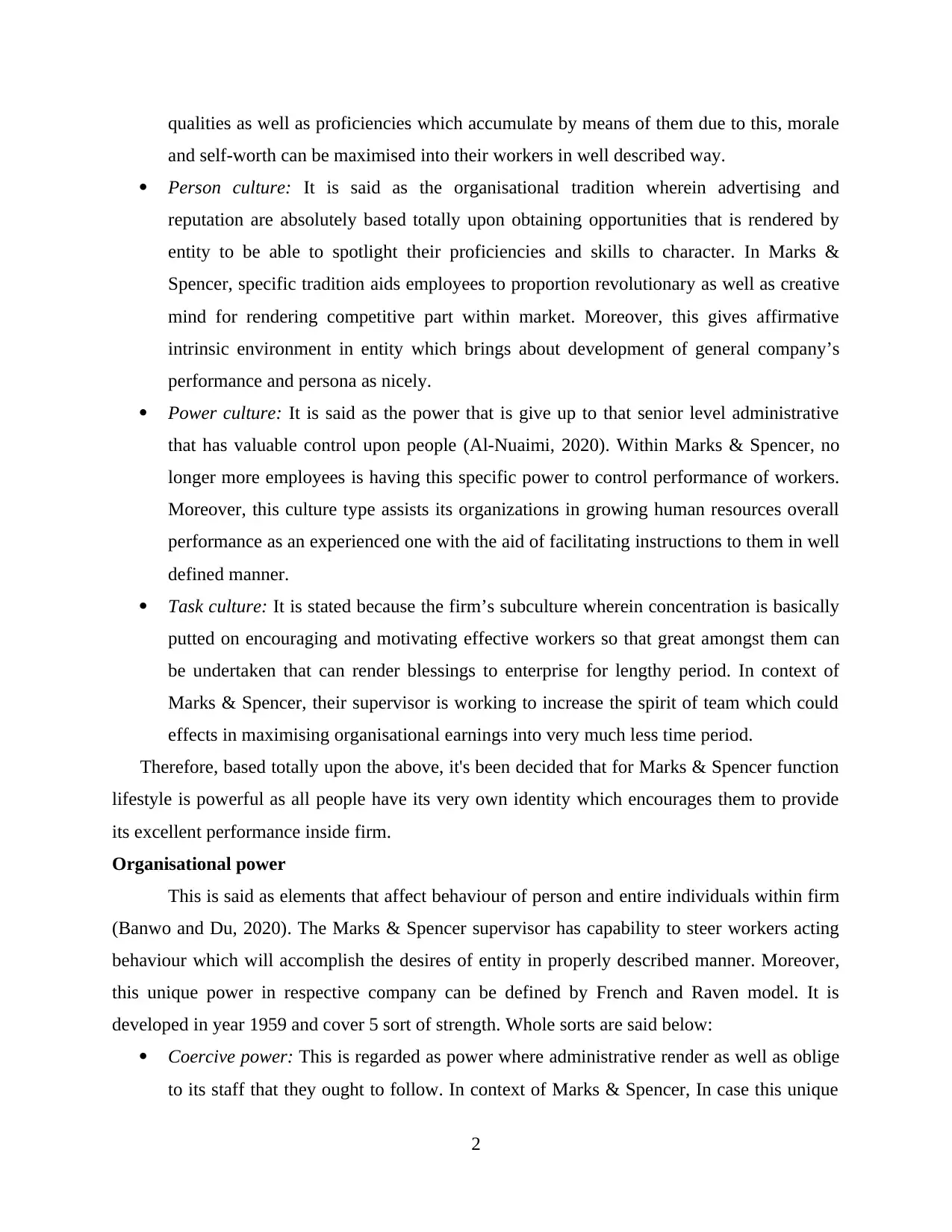
qualities as well as proficiencies which accumulate by means of them due to this, morale
and self-worth can be maximised into their workers in well described way.
Person culture: It is said as the organisational tradition wherein advertising and
reputation are absolutely based totally upon obtaining opportunities that is rendered by
entity to be able to spotlight their proficiencies and skills to character. In Marks &
Spencer, specific tradition aids employees to proportion revolutionary as well as creative
mind for rendering competitive part within market. Moreover, this gives affirmative
intrinsic environment in entity which brings about development of general company’s
performance and persona as nicely.
Power culture: It is said as the power that is give up to that senior level administrative
that has valuable control upon people (Al-Nuaimi, 2020). Within Marks & Spencer, no
longer more employees is having this specific power to control performance of workers.
Moreover, this culture type assists its organizations in growing human resources overall
performance as an experienced one with the aid of facilitating instructions to them in well
defined manner.
Task culture: It is stated because the firm’s subculture wherein concentration is basically
putted on encouraging and motivating effective workers so that great amongst them can
be undertaken that can render blessings to enterprise for lengthy period. In context of
Marks & Spencer, their supervisor is working to increase the spirit of team which could
effects in maximising organisational earnings into very much less time period.
Therefore, based totally upon the above, it's been decided that for Marks & Spencer function
lifestyle is powerful as all people have its very own identity which encourages them to provide
its excellent performance inside firm.
Organisational power
This is said as elements that affect behaviour of person and entire individuals within firm
(Banwo and Du, 2020). The Marks & Spencer supervisor has capability to steer workers acting
behaviour which will accomplish the desires of entity in properly described manner. Moreover,
this unique power in respective company can be defined by French and Raven model. It is
developed in year 1959 and cover 5 sort of strength. Whole sorts are said below:
Coercive power: This is regarded as power where administrative render as well as oblige
to its staff that they ought to follow. In context of Marks & Spencer, In case this unique
2
and self-worth can be maximised into their workers in well described way.
Person culture: It is said as the organisational tradition wherein advertising and
reputation are absolutely based totally upon obtaining opportunities that is rendered by
entity to be able to spotlight their proficiencies and skills to character. In Marks &
Spencer, specific tradition aids employees to proportion revolutionary as well as creative
mind for rendering competitive part within market. Moreover, this gives affirmative
intrinsic environment in entity which brings about development of general company’s
performance and persona as nicely.
Power culture: It is said as the power that is give up to that senior level administrative
that has valuable control upon people (Al-Nuaimi, 2020). Within Marks & Spencer, no
longer more employees is having this specific power to control performance of workers.
Moreover, this culture type assists its organizations in growing human resources overall
performance as an experienced one with the aid of facilitating instructions to them in well
defined manner.
Task culture: It is stated because the firm’s subculture wherein concentration is basically
putted on encouraging and motivating effective workers so that great amongst them can
be undertaken that can render blessings to enterprise for lengthy period. In context of
Marks & Spencer, their supervisor is working to increase the spirit of team which could
effects in maximising organisational earnings into very much less time period.
Therefore, based totally upon the above, it's been decided that for Marks & Spencer function
lifestyle is powerful as all people have its very own identity which encourages them to provide
its excellent performance inside firm.
Organisational power
This is said as elements that affect behaviour of person and entire individuals within firm
(Banwo and Du, 2020). The Marks & Spencer supervisor has capability to steer workers acting
behaviour which will accomplish the desires of entity in properly described manner. Moreover,
this unique power in respective company can be defined by French and Raven model. It is
developed in year 1959 and cover 5 sort of strength. Whole sorts are said below:
Coercive power: This is regarded as power where administrative render as well as oblige
to its staff that they ought to follow. In context of Marks & Spencer, In case this unique
2
Secure Best Marks with AI Grader
Need help grading? Try our AI Grader for instant feedback on your assignments.
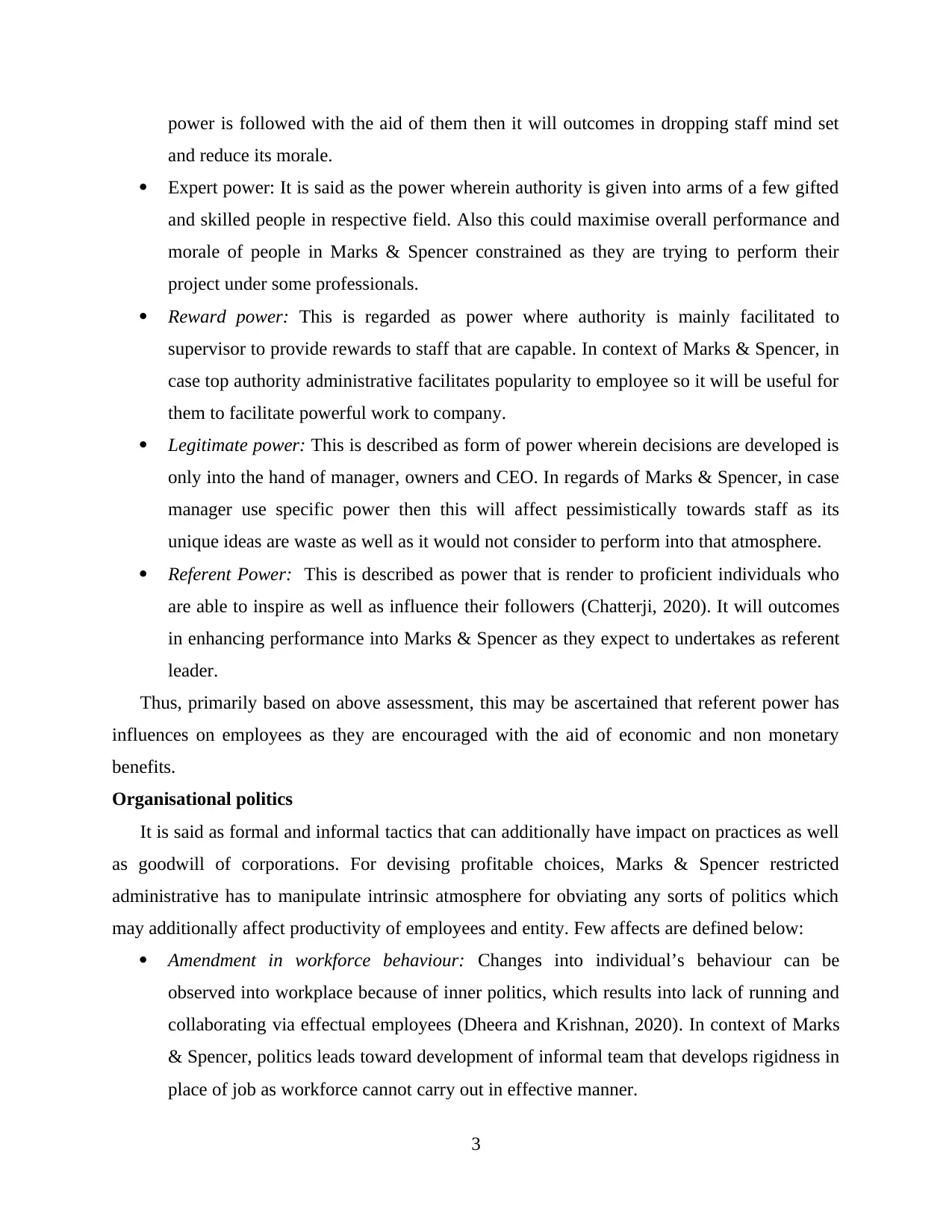
power is followed with the aid of them then it will outcomes in dropping staff mind set
and reduce its morale.
Expert power: It is said as the power wherein authority is given into arms of a few gifted
and skilled people in respective field. Also this could maximise overall performance and
morale of people in Marks & Spencer constrained as they are trying to perform their
project under some professionals.
Reward power: This is regarded as power where authority is mainly facilitated to
supervisor to provide rewards to staff that are capable. In context of Marks & Spencer, in
case top authority administrative facilitates popularity to employee so it will be useful for
them to facilitate powerful work to company.
Legitimate power: This is described as form of power wherein decisions are developed is
only into the hand of manager, owners and CEO. In regards of Marks & Spencer, in case
manager use specific power then this will affect pessimistically towards staff as its
unique ideas are waste as well as it would not consider to perform into that atmosphere.
Referent Power: This is described as power that is render to proficient individuals who
are able to inspire as well as influence their followers (Chatterji, 2020). It will outcomes
in enhancing performance into Marks & Spencer as they expect to undertakes as referent
leader.
Thus, primarily based on above assessment, this may be ascertained that referent power has
influences on employees as they are encouraged with the aid of economic and non monetary
benefits.
Organisational politics
It is said as formal and informal tactics that can additionally have impact on practices as well
as goodwill of corporations. For devising profitable choices, Marks & Spencer restricted
administrative has to manipulate intrinsic atmosphere for obviating any sorts of politics which
may additionally affect productivity of employees and entity. Few affects are defined below:
Amendment in workforce behaviour: Changes into individual’s behaviour can be
observed into workplace because of inner politics, which results into lack of running and
collaborating via effectual employees (Dheera and Krishnan, 2020). In context of Marks
& Spencer, politics leads toward development of informal team that develops rigidness in
place of job as workforce cannot carry out in effective manner.
3
and reduce its morale.
Expert power: It is said as the power wherein authority is given into arms of a few gifted
and skilled people in respective field. Also this could maximise overall performance and
morale of people in Marks & Spencer constrained as they are trying to perform their
project under some professionals.
Reward power: This is regarded as power where authority is mainly facilitated to
supervisor to provide rewards to staff that are capable. In context of Marks & Spencer, in
case top authority administrative facilitates popularity to employee so it will be useful for
them to facilitate powerful work to company.
Legitimate power: This is described as form of power wherein decisions are developed is
only into the hand of manager, owners and CEO. In regards of Marks & Spencer, in case
manager use specific power then this will affect pessimistically towards staff as its
unique ideas are waste as well as it would not consider to perform into that atmosphere.
Referent Power: This is described as power that is render to proficient individuals who
are able to inspire as well as influence their followers (Chatterji, 2020). It will outcomes
in enhancing performance into Marks & Spencer as they expect to undertakes as referent
leader.
Thus, primarily based on above assessment, this may be ascertained that referent power has
influences on employees as they are encouraged with the aid of economic and non monetary
benefits.
Organisational politics
It is said as formal and informal tactics that can additionally have impact on practices as well
as goodwill of corporations. For devising profitable choices, Marks & Spencer restricted
administrative has to manipulate intrinsic atmosphere for obviating any sorts of politics which
may additionally affect productivity of employees and entity. Few affects are defined below:
Amendment in workforce behaviour: Changes into individual’s behaviour can be
observed into workplace because of inner politics, which results into lack of running and
collaborating via effectual employees (Dheera and Krishnan, 2020). In context of Marks
& Spencer, politics leads toward development of informal team that develops rigidness in
place of job as workforce cannot carry out in effective manner.
3
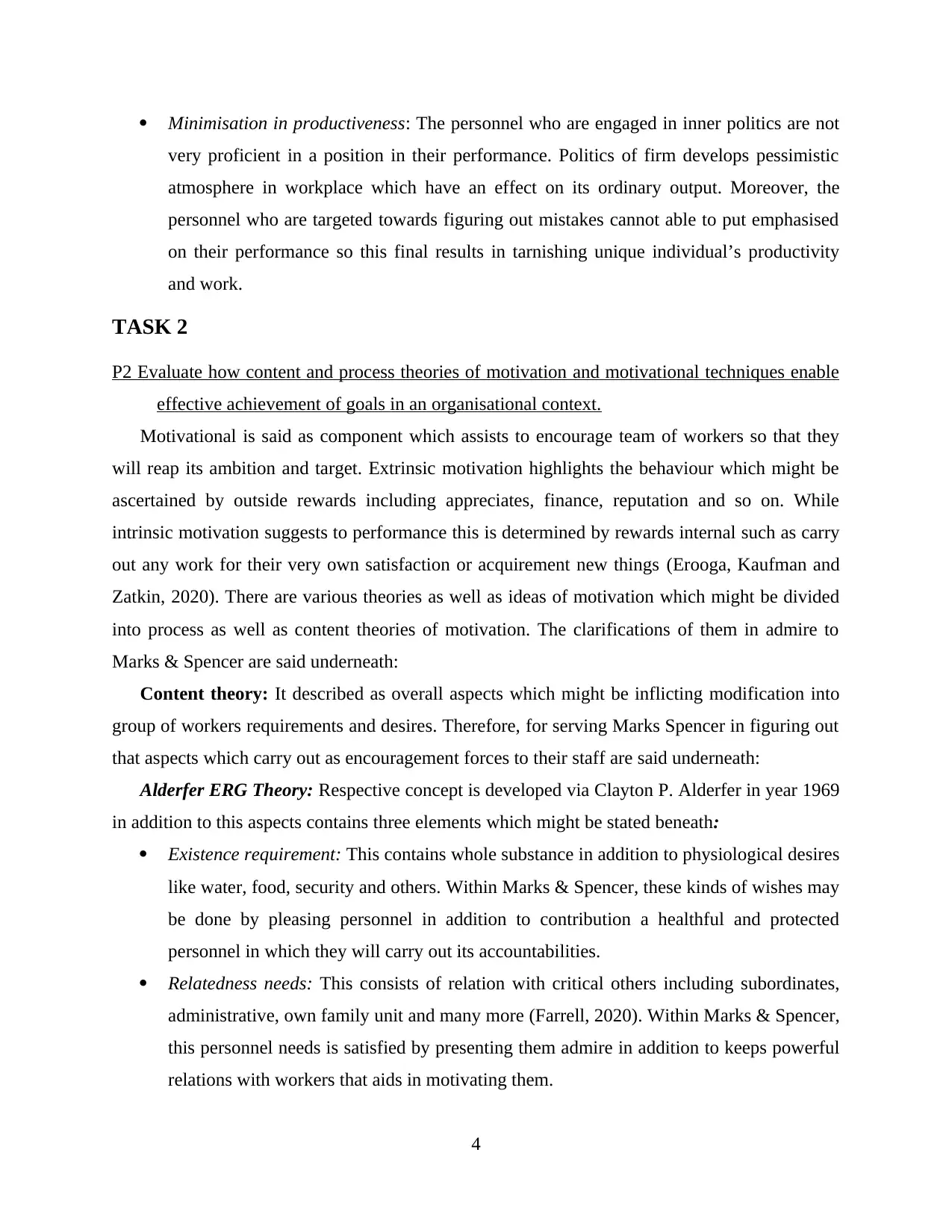
Minimisation in productiveness: The personnel who are engaged in inner politics are not
very proficient in a position in their performance. Politics of firm develops pessimistic
atmosphere in workplace which have an effect on its ordinary output. Moreover, the
personnel who are targeted towards figuring out mistakes cannot able to put emphasised
on their performance so this final results in tarnishing unique individual’s productivity
and work.
TASK 2
P2 Evaluate how content and process theories of motivation and motivational techniques enable
effective achievement of goals in an organisational context.
Motivational is said as component which assists to encourage team of workers so that they
will reap its ambition and target. Extrinsic motivation highlights the behaviour which might be
ascertained by outside rewards including appreciates, finance, reputation and so on. While
intrinsic motivation suggests to performance this is determined by rewards internal such as carry
out any work for their very own satisfaction or acquirement new things (Erooga, Kaufman and
Zatkin, 2020). There are various theories as well as ideas of motivation which might be divided
into process as well as content theories of motivation. The clarifications of them in admire to
Marks & Spencer are said underneath:
Content theory: It described as overall aspects which might be inflicting modification into
group of workers requirements and desires. Therefore, for serving Marks Spencer in figuring out
that aspects which carry out as encouragement forces to their staff are said underneath:
Alderfer ERG Theory: Respective concept is developed via Clayton P. Alderfer in year 1969
in addition to this aspects contains three elements which might be stated beneath:
Existence requirement: This contains whole substance in addition to physiological desires
like water, food, security and others. Within Marks & Spencer, these kinds of wishes may
be done by pleasing personnel in addition to contribution a healthful and protected
personnel in which they will carry out its accountabilities.
Relatedness needs: This consists of relation with critical others including subordinates,
administrative, own family unit and many more (Farrell, 2020). Within Marks & Spencer,
this personnel needs is satisfied by presenting them admire in addition to keeps powerful
relations with workers that aids in motivating them.
4
very proficient in a position in their performance. Politics of firm develops pessimistic
atmosphere in workplace which have an effect on its ordinary output. Moreover, the
personnel who are targeted towards figuring out mistakes cannot able to put emphasised
on their performance so this final results in tarnishing unique individual’s productivity
and work.
TASK 2
P2 Evaluate how content and process theories of motivation and motivational techniques enable
effective achievement of goals in an organisational context.
Motivational is said as component which assists to encourage team of workers so that they
will reap its ambition and target. Extrinsic motivation highlights the behaviour which might be
ascertained by outside rewards including appreciates, finance, reputation and so on. While
intrinsic motivation suggests to performance this is determined by rewards internal such as carry
out any work for their very own satisfaction or acquirement new things (Erooga, Kaufman and
Zatkin, 2020). There are various theories as well as ideas of motivation which might be divided
into process as well as content theories of motivation. The clarifications of them in admire to
Marks & Spencer are said underneath:
Content theory: It described as overall aspects which might be inflicting modification into
group of workers requirements and desires. Therefore, for serving Marks Spencer in figuring out
that aspects which carry out as encouragement forces to their staff are said underneath:
Alderfer ERG Theory: Respective concept is developed via Clayton P. Alderfer in year 1969
in addition to this aspects contains three elements which might be stated beneath:
Existence requirement: This contains whole substance in addition to physiological desires
like water, food, security and others. Within Marks & Spencer, these kinds of wishes may
be done by pleasing personnel in addition to contribution a healthful and protected
personnel in which they will carry out its accountabilities.
Relatedness needs: This consists of relation with critical others including subordinates,
administrative, own family unit and many more (Farrell, 2020). Within Marks & Spencer,
this personnel needs is satisfied by presenting them admire in addition to keeps powerful
relations with workers that aids in motivating them.
4
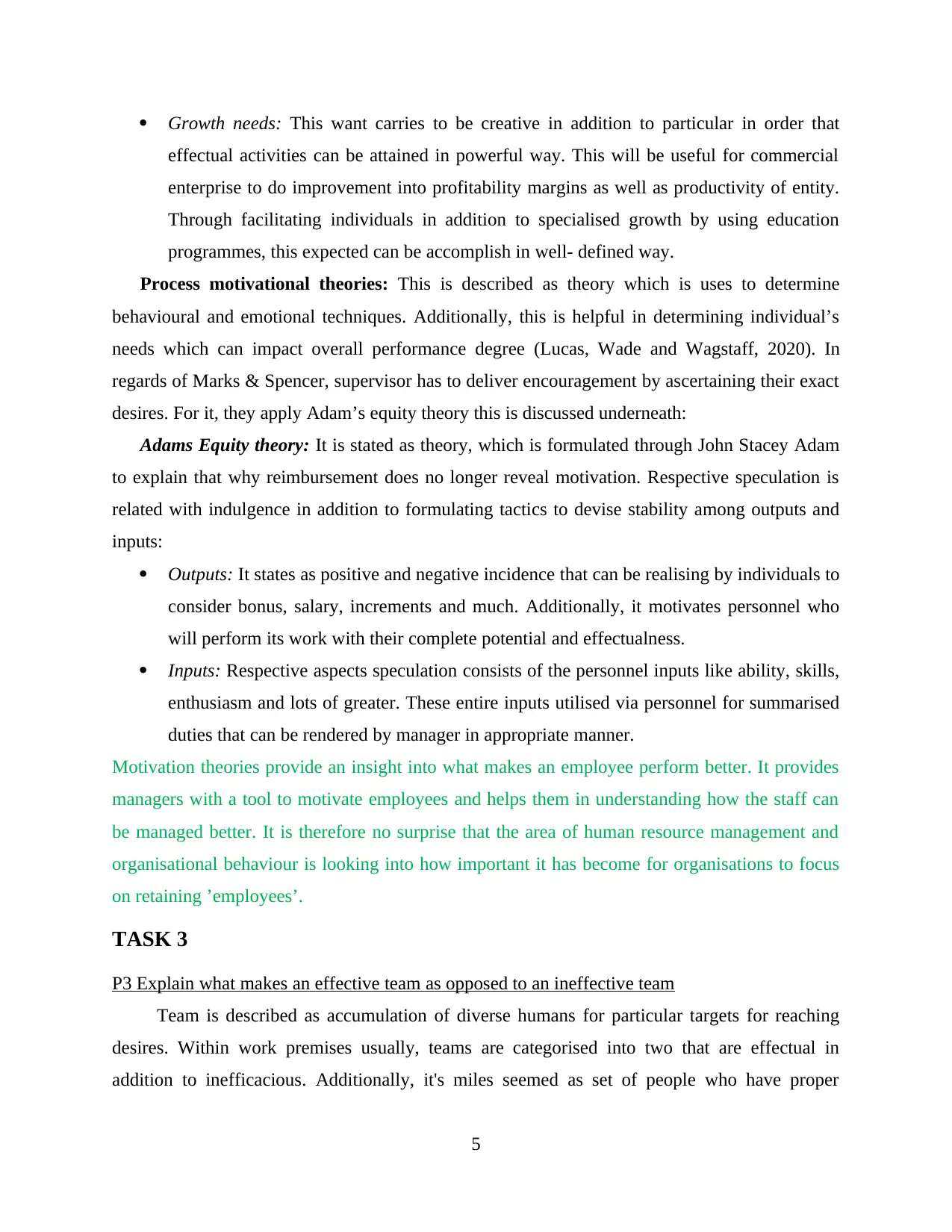
Growth needs: This want carries to be creative in addition to particular in order that
effectual activities can be attained in powerful way. This will be useful for commercial
enterprise to do improvement into profitability margins as well as productivity of entity.
Through facilitating individuals in addition to specialised growth by using education
programmes, this expected can be accomplish in well- defined way.
Process motivational theories: This is described as theory which is uses to determine
behavioural and emotional techniques. Additionally, this is helpful in determining individual’s
needs which can impact overall performance degree (Lucas, Wade and Wagstaff, 2020). In
regards of Marks & Spencer, supervisor has to deliver encouragement by ascertaining their exact
desires. For it, they apply Adam’s equity theory this is discussed underneath:
Adams Equity theory: It is stated as theory, which is formulated through John Stacey Adam
to explain that why reimbursement does no longer reveal motivation. Respective speculation is
related with indulgence in addition to formulating tactics to devise stability among outputs and
inputs:
Outputs: It states as positive and negative incidence that can be realising by individuals to
consider bonus, salary, increments and much. Additionally, it motivates personnel who
will perform its work with their complete potential and effectualness.
Inputs: Respective aspects speculation consists of the personnel inputs like ability, skills,
enthusiasm and lots of greater. These entire inputs utilised via personnel for summarised
duties that can be rendered by manager in appropriate manner.
Motivation theories provide an insight into what makes an employee perform better. It provides
managers with a tool to motivate employees and helps them in understanding how the staff can
be managed better. It is therefore no surprise that the area of human resource management and
organisational behaviour is looking into how important it has become for organisations to focus
on retaining ’employees’.
TASK 3
P3 Explain what makes an effective team as opposed to an ineffective team
Team is described as accumulation of diverse humans for particular targets for reaching
desires. Within work premises usually, teams are categorised into two that are effectual in
addition to inefficacious. Additionally, it's miles seemed as set of people who have proper
5
effectual activities can be attained in powerful way. This will be useful for commercial
enterprise to do improvement into profitability margins as well as productivity of entity.
Through facilitating individuals in addition to specialised growth by using education
programmes, this expected can be accomplish in well- defined way.
Process motivational theories: This is described as theory which is uses to determine
behavioural and emotional techniques. Additionally, this is helpful in determining individual’s
needs which can impact overall performance degree (Lucas, Wade and Wagstaff, 2020). In
regards of Marks & Spencer, supervisor has to deliver encouragement by ascertaining their exact
desires. For it, they apply Adam’s equity theory this is discussed underneath:
Adams Equity theory: It is stated as theory, which is formulated through John Stacey Adam
to explain that why reimbursement does no longer reveal motivation. Respective speculation is
related with indulgence in addition to formulating tactics to devise stability among outputs and
inputs:
Outputs: It states as positive and negative incidence that can be realising by individuals to
consider bonus, salary, increments and much. Additionally, it motivates personnel who
will perform its work with their complete potential and effectualness.
Inputs: Respective aspects speculation consists of the personnel inputs like ability, skills,
enthusiasm and lots of greater. These entire inputs utilised via personnel for summarised
duties that can be rendered by manager in appropriate manner.
Motivation theories provide an insight into what makes an employee perform better. It provides
managers with a tool to motivate employees and helps them in understanding how the staff can
be managed better. It is therefore no surprise that the area of human resource management and
organisational behaviour is looking into how important it has become for organisations to focus
on retaining ’employees’.
TASK 3
P3 Explain what makes an effective team as opposed to an ineffective team
Team is described as accumulation of diverse humans for particular targets for reaching
desires. Within work premises usually, teams are categorised into two that are effectual in
addition to inefficacious. Additionally, it's miles seemed as set of people who have proper
5
Paraphrase This Document
Need a fresh take? Get an instant paraphrase of this document with our AI Paraphraser
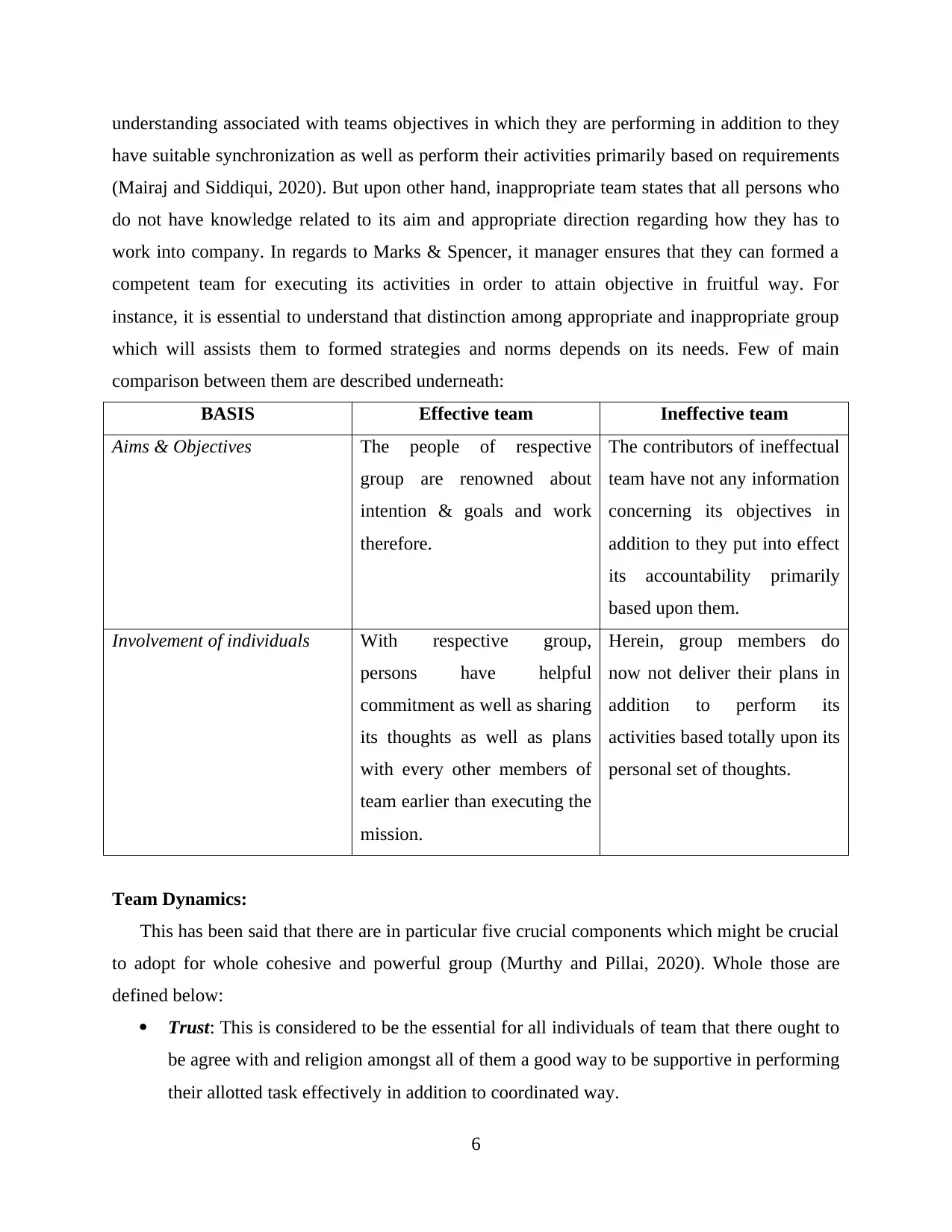
understanding associated with teams objectives in which they are performing in addition to they
have suitable synchronization as well as perform their activities primarily based on requirements
(Mairaj and Siddiqui, 2020). But upon other hand, inappropriate team states that all persons who
do not have knowledge related to its aim and appropriate direction regarding how they has to
work into company. In regards to Marks & Spencer, it manager ensures that they can formed a
competent team for executing its activities in order to attain objective in fruitful way. For
instance, it is essential to understand that distinction among appropriate and inappropriate group
which will assists them to formed strategies and norms depends on its needs. Few of main
comparison between them are described underneath:
BASIS Effective team Ineffective team
Aims & Objectives The people of respective
group are renowned about
intention & goals and work
therefore.
The contributors of ineffectual
team have not any information
concerning its objectives in
addition to they put into effect
its accountability primarily
based upon them.
Involvement of individuals With respective group,
persons have helpful
commitment as well as sharing
its thoughts as well as plans
with every other members of
team earlier than executing the
mission.
Herein, group members do
now not deliver their plans in
addition to perform its
activities based totally upon its
personal set of thoughts.
Team Dynamics:
This has been said that there are in particular five crucial components which might be crucial
to adopt for whole cohesive and powerful group (Murthy and Pillai, 2020). Whole those are
defined below:
Trust: This is considered to be the essential for all individuals of team that there ought to
be agree with and religion amongst all of them a good way to be supportive in performing
their allotted task effectively in addition to coordinated way.
6
have suitable synchronization as well as perform their activities primarily based on requirements
(Mairaj and Siddiqui, 2020). But upon other hand, inappropriate team states that all persons who
do not have knowledge related to its aim and appropriate direction regarding how they has to
work into company. In regards to Marks & Spencer, it manager ensures that they can formed a
competent team for executing its activities in order to attain objective in fruitful way. For
instance, it is essential to understand that distinction among appropriate and inappropriate group
which will assists them to formed strategies and norms depends on its needs. Few of main
comparison between them are described underneath:
BASIS Effective team Ineffective team
Aims & Objectives The people of respective
group are renowned about
intention & goals and work
therefore.
The contributors of ineffectual
team have not any information
concerning its objectives in
addition to they put into effect
its accountability primarily
based upon them.
Involvement of individuals With respective group,
persons have helpful
commitment as well as sharing
its thoughts as well as plans
with every other members of
team earlier than executing the
mission.
Herein, group members do
now not deliver their plans in
addition to perform its
activities based totally upon its
personal set of thoughts.
Team Dynamics:
This has been said that there are in particular five crucial components which might be crucial
to adopt for whole cohesive and powerful group (Murthy and Pillai, 2020). Whole those are
defined below:
Trust: This is considered to be the essential for all individuals of team that there ought to
be agree with and religion amongst all of them a good way to be supportive in performing
their allotted task effectively in addition to coordinated way.
6
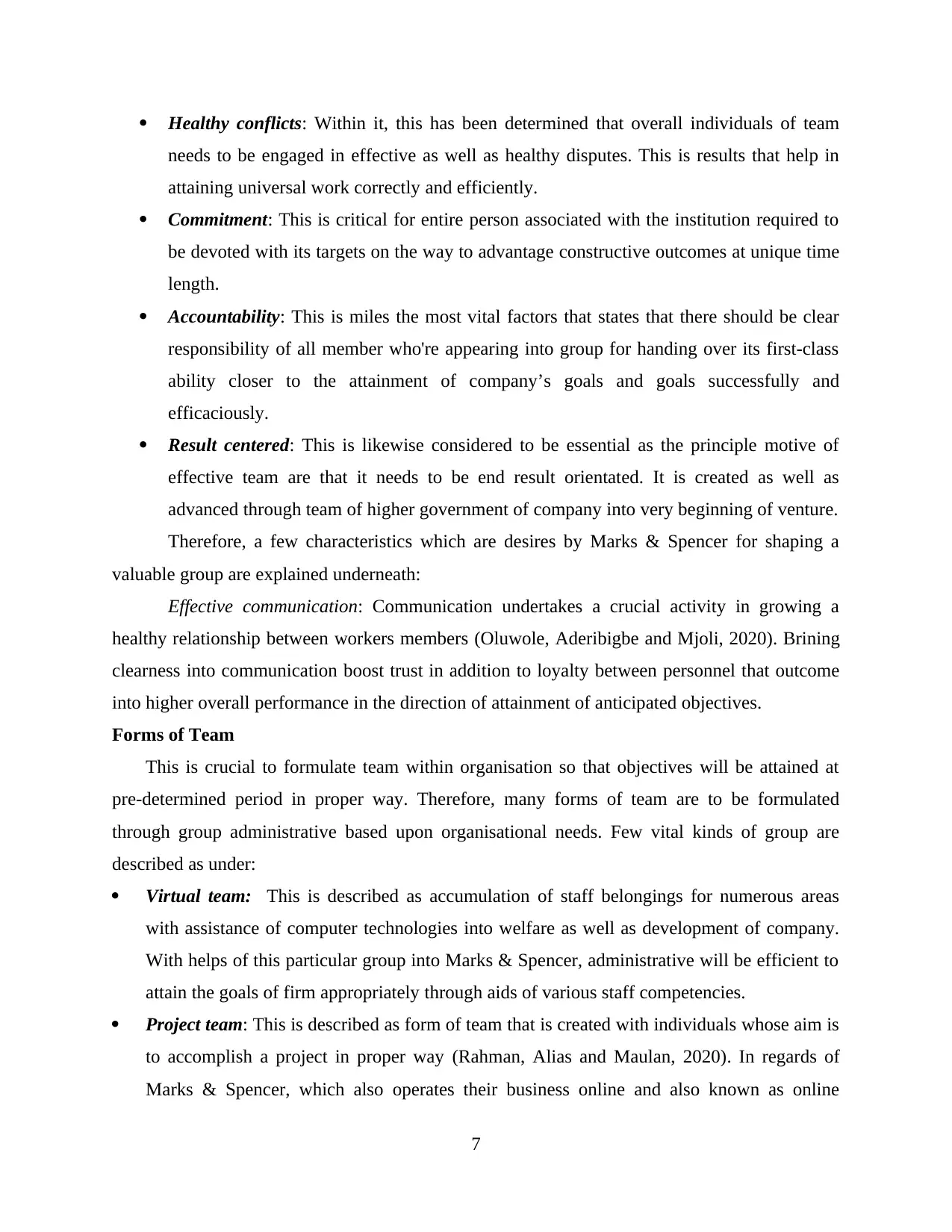
Healthy conflicts: Within it, this has been determined that overall individuals of team
needs to be engaged in effective as well as healthy disputes. This is results that help in
attaining universal work correctly and efficiently.
Commitment: This is critical for entire person associated with the institution required to
be devoted with its targets on the way to advantage constructive outcomes at unique time
length.
Accountability: This is miles the most vital factors that states that there should be clear
responsibility of all member who're appearing into group for handing over its first-class
ability closer to the attainment of company’s goals and goals successfully and
efficaciously.
Result centered: This is likewise considered to be essential as the principle motive of
effective team are that it needs to be end result orientated. It is created as well as
advanced through team of higher government of company into very beginning of venture.
Therefore, a few characteristics which are desires by Marks & Spencer for shaping a
valuable group are explained underneath:
Effective communication: Communication undertakes a crucial activity in growing a
healthy relationship between workers members (Oluwole, Aderibigbe and Mjoli, 2020). Brining
clearness into communication boost trust in addition to loyalty between personnel that outcome
into higher overall performance in the direction of attainment of anticipated objectives.
Forms of Team
This is crucial to formulate team within organisation so that objectives will be attained at
pre-determined period in proper way. Therefore, many forms of team are to be formulated
through group administrative based upon organisational needs. Few vital kinds of group are
described as under:
Virtual team: This is described as accumulation of staff belongings for numerous areas
with assistance of computer technologies into welfare as well as development of company.
With helps of this particular group into Marks & Spencer, administrative will be efficient to
attain the goals of firm appropriately through aids of various staff competencies.
Project team: This is described as form of team that is created with individuals whose aim is
to accomplish a project in proper way (Rahman, Alias and Maulan, 2020). In regards of
Marks & Spencer, which also operates their business online and also known as online
7
needs to be engaged in effective as well as healthy disputes. This is results that help in
attaining universal work correctly and efficiently.
Commitment: This is critical for entire person associated with the institution required to
be devoted with its targets on the way to advantage constructive outcomes at unique time
length.
Accountability: This is miles the most vital factors that states that there should be clear
responsibility of all member who're appearing into group for handing over its first-class
ability closer to the attainment of company’s goals and goals successfully and
efficaciously.
Result centered: This is likewise considered to be essential as the principle motive of
effective team are that it needs to be end result orientated. It is created as well as
advanced through team of higher government of company into very beginning of venture.
Therefore, a few characteristics which are desires by Marks & Spencer for shaping a
valuable group are explained underneath:
Effective communication: Communication undertakes a crucial activity in growing a
healthy relationship between workers members (Oluwole, Aderibigbe and Mjoli, 2020). Brining
clearness into communication boost trust in addition to loyalty between personnel that outcome
into higher overall performance in the direction of attainment of anticipated objectives.
Forms of Team
This is crucial to formulate team within organisation so that objectives will be attained at
pre-determined period in proper way. Therefore, many forms of team are to be formulated
through group administrative based upon organisational needs. Few vital kinds of group are
described as under:
Virtual team: This is described as accumulation of staff belongings for numerous areas
with assistance of computer technologies into welfare as well as development of company.
With helps of this particular group into Marks & Spencer, administrative will be efficient to
attain the goals of firm appropriately through aids of various staff competencies.
Project team: This is described as form of team that is created with individuals whose aim is
to accomplish a project in proper way (Rahman, Alias and Maulan, 2020). In regards of
Marks & Spencer, which also operates their business online and also known as online
7
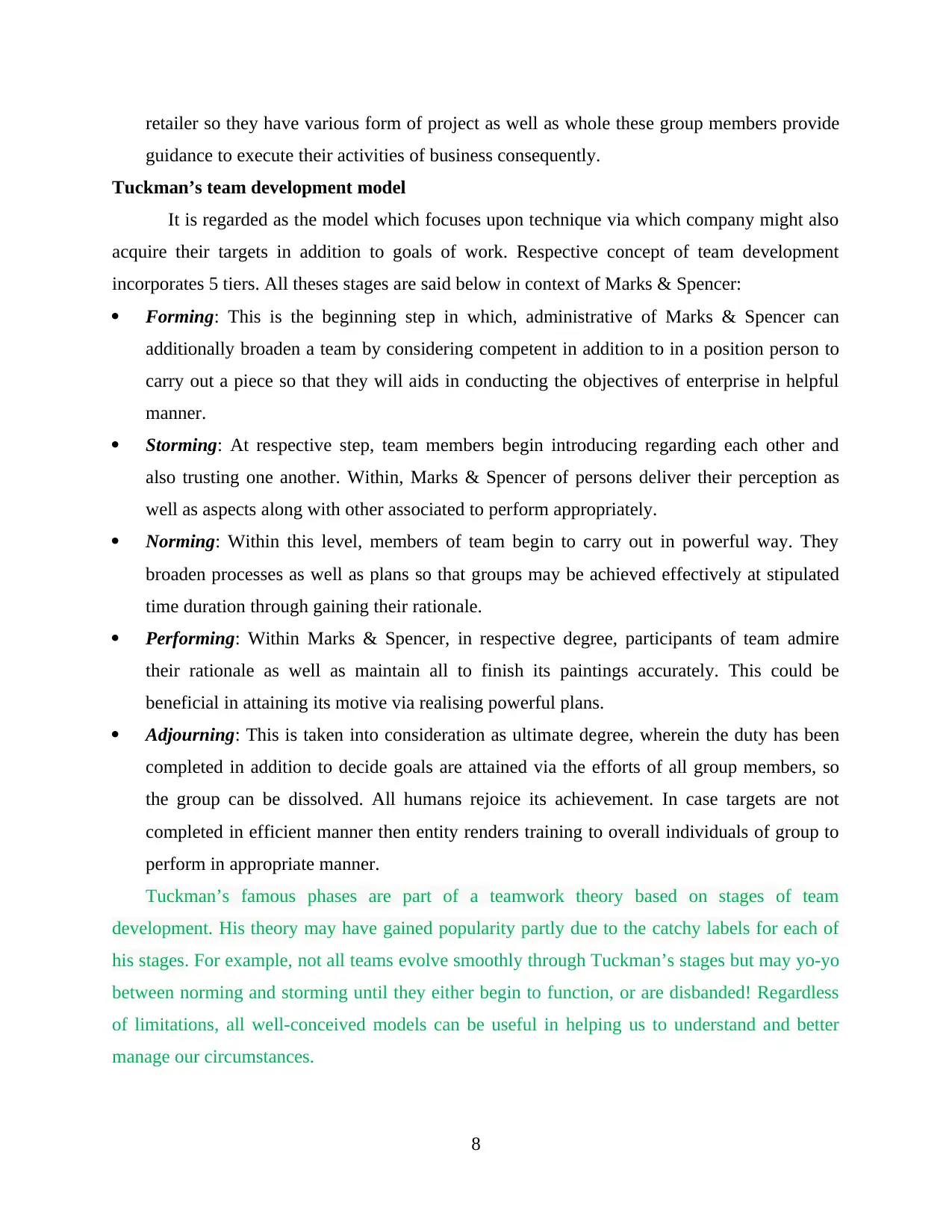
retailer so they have various form of project as well as whole these group members provide
guidance to execute their activities of business consequently.
Tuckman’s team development model
It is regarded as the model which focuses upon technique via which company might also
acquire their targets in addition to goals of work. Respective concept of team development
incorporates 5 tiers. All theses stages are said below in context of Marks & Spencer:
Forming: This is the beginning step in which, administrative of Marks & Spencer can
additionally broaden a team by considering competent in addition to in a position person to
carry out a piece so that they will aids in conducting the objectives of enterprise in helpful
manner.
Storming: At respective step, team members begin introducing regarding each other and
also trusting one another. Within, Marks & Spencer of persons deliver their perception as
well as aspects along with other associated to perform appropriately.
Norming: Within this level, members of team begin to carry out in powerful way. They
broaden processes as well as plans so that groups may be achieved effectively at stipulated
time duration through gaining their rationale.
Performing: Within Marks & Spencer, in respective degree, participants of team admire
their rationale as well as maintain all to finish its paintings accurately. This could be
beneficial in attaining its motive via realising powerful plans.
Adjourning: This is taken into consideration as ultimate degree, wherein the duty has been
completed in addition to decide goals are attained via the efforts of all group members, so
the group can be dissolved. All humans rejoice its achievement. In case targets are not
completed in efficient manner then entity renders training to overall individuals of group to
perform in appropriate manner.
Tuckman’s famous phases are part of a teamwork theory based on stages of team
development. His theory may have gained popularity partly due to the catchy labels for each of
his stages. For example, not all teams evolve smoothly through Tuckman’s stages but may yo-yo
between norming and storming until they either begin to function, or are disbanded! Regardless
of limitations, all well-conceived models can be useful in helping us to understand and better
manage our circumstances.
8
guidance to execute their activities of business consequently.
Tuckman’s team development model
It is regarded as the model which focuses upon technique via which company might also
acquire their targets in addition to goals of work. Respective concept of team development
incorporates 5 tiers. All theses stages are said below in context of Marks & Spencer:
Forming: This is the beginning step in which, administrative of Marks & Spencer can
additionally broaden a team by considering competent in addition to in a position person to
carry out a piece so that they will aids in conducting the objectives of enterprise in helpful
manner.
Storming: At respective step, team members begin introducing regarding each other and
also trusting one another. Within, Marks & Spencer of persons deliver their perception as
well as aspects along with other associated to perform appropriately.
Norming: Within this level, members of team begin to carry out in powerful way. They
broaden processes as well as plans so that groups may be achieved effectively at stipulated
time duration through gaining their rationale.
Performing: Within Marks & Spencer, in respective degree, participants of team admire
their rationale as well as maintain all to finish its paintings accurately. This could be
beneficial in attaining its motive via realising powerful plans.
Adjourning: This is taken into consideration as ultimate degree, wherein the duty has been
completed in addition to decide goals are attained via the efforts of all group members, so
the group can be dissolved. All humans rejoice its achievement. In case targets are not
completed in efficient manner then entity renders training to overall individuals of group to
perform in appropriate manner.
Tuckman’s famous phases are part of a teamwork theory based on stages of team
development. His theory may have gained popularity partly due to the catchy labels for each of
his stages. For example, not all teams evolve smoothly through Tuckman’s stages but may yo-yo
between norming and storming until they either begin to function, or are disbanded! Regardless
of limitations, all well-conceived models can be useful in helping us to understand and better
manage our circumstances.
8
Secure Best Marks with AI Grader
Need help grading? Try our AI Grader for instant feedback on your assignments.
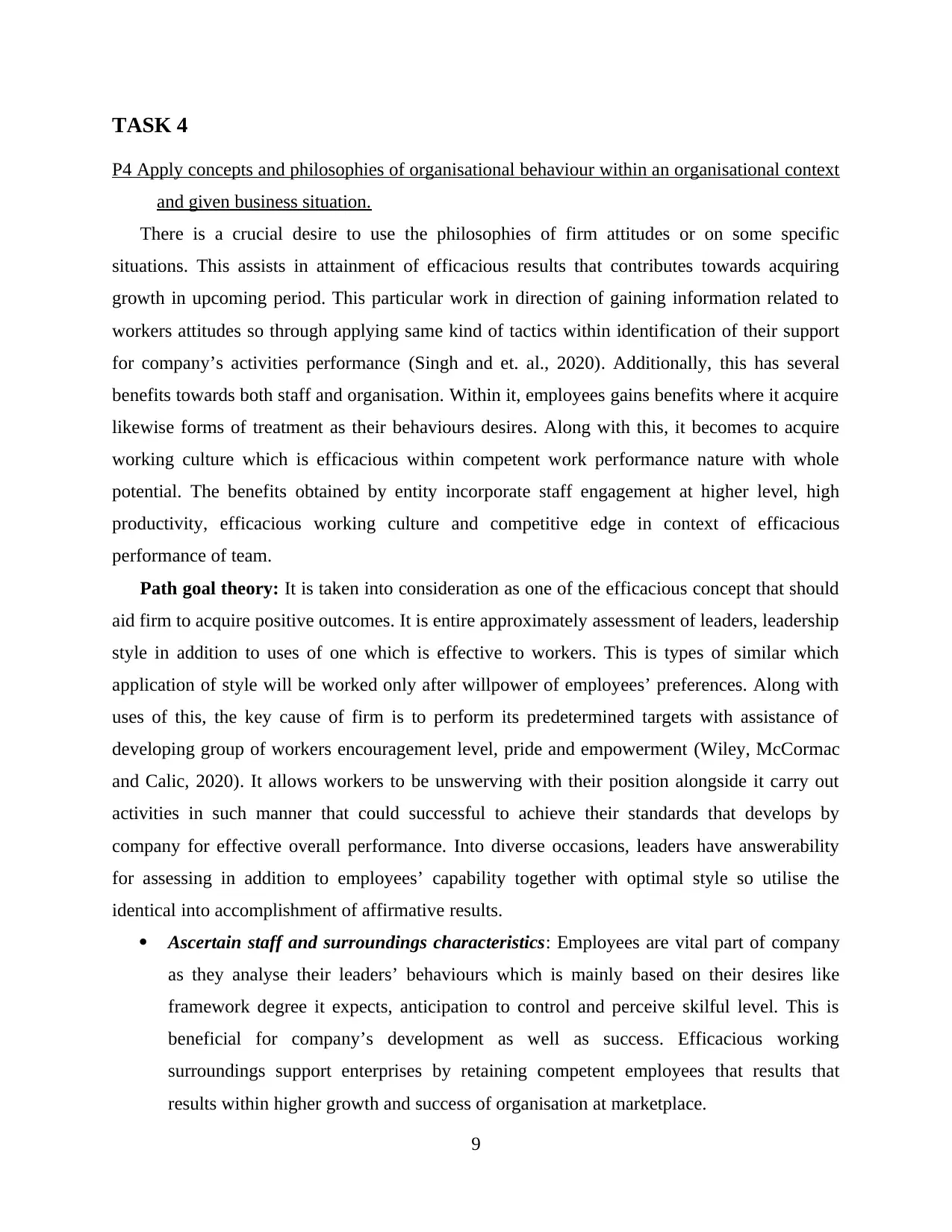
TASK 4
P4 Apply concepts and philosophies of organisational behaviour within an organisational context
and given business situation.
There is a crucial desire to use the philosophies of firm attitudes or on some specific
situations. This assists in attainment of efficacious results that contributes towards acquiring
growth in upcoming period. This particular work in direction of gaining information related to
workers attitudes so through applying same kind of tactics within identification of their support
for company’s activities performance (Singh and et. al., 2020). Additionally, this has several
benefits towards both staff and organisation. Within it, employees gains benefits where it acquire
likewise forms of treatment as their behaviours desires. Along with this, it becomes to acquire
working culture which is efficacious within competent work performance nature with whole
potential. The benefits obtained by entity incorporate staff engagement at higher level, high
productivity, efficacious working culture and competitive edge in context of efficacious
performance of team.
Path goal theory: It is taken into consideration as one of the efficacious concept that should
aid firm to acquire positive outcomes. It is entire approximately assessment of leaders, leadership
style in addition to uses of one which is effective to workers. This is types of similar which
application of style will be worked only after willpower of employees’ preferences. Along with
uses of this, the key cause of firm is to perform its predetermined targets with assistance of
developing group of workers encouragement level, pride and empowerment (Wiley, McCormac
and Calic, 2020). It allows workers to be unswerving with their position alongside it carry out
activities in such manner that could successful to achieve their standards that develops by
company for effective overall performance. Into diverse occasions, leaders have answerability
for assessing in addition to employees’ capability together with optimal style so utilise the
identical into accomplishment of affirmative results.
Ascertain staff and surroundings characteristics: Employees are vital part of company
as they analyse their leaders’ behaviours which is mainly based on their desires like
framework degree it expects, anticipation to control and perceive skilful level. This is
beneficial for company’s development as well as success. Efficacious working
surroundings support enterprises by retaining competent employees that results that
results within higher growth and success of organisation at marketplace.
9
P4 Apply concepts and philosophies of organisational behaviour within an organisational context
and given business situation.
There is a crucial desire to use the philosophies of firm attitudes or on some specific
situations. This assists in attainment of efficacious results that contributes towards acquiring
growth in upcoming period. This particular work in direction of gaining information related to
workers attitudes so through applying same kind of tactics within identification of their support
for company’s activities performance (Singh and et. al., 2020). Additionally, this has several
benefits towards both staff and organisation. Within it, employees gains benefits where it acquire
likewise forms of treatment as their behaviours desires. Along with this, it becomes to acquire
working culture which is efficacious within competent work performance nature with whole
potential. The benefits obtained by entity incorporate staff engagement at higher level, high
productivity, efficacious working culture and competitive edge in context of efficacious
performance of team.
Path goal theory: It is taken into consideration as one of the efficacious concept that should
aid firm to acquire positive outcomes. It is entire approximately assessment of leaders, leadership
style in addition to uses of one which is effective to workers. This is types of similar which
application of style will be worked only after willpower of employees’ preferences. Along with
uses of this, the key cause of firm is to perform its predetermined targets with assistance of
developing group of workers encouragement level, pride and empowerment (Wiley, McCormac
and Calic, 2020). It allows workers to be unswerving with their position alongside it carry out
activities in such manner that could successful to achieve their standards that develops by
company for effective overall performance. Into diverse occasions, leaders have answerability
for assessing in addition to employees’ capability together with optimal style so utilise the
identical into accomplishment of affirmative results.
Ascertain staff and surroundings characteristics: Employees are vital part of company
as they analyse their leaders’ behaviours which is mainly based on their desires like
framework degree it expects, anticipation to control and perceive skilful level. This is
beneficial for company’s development as well as success. Efficacious working
surroundings support enterprises by retaining competent employees that results that
results within higher growth and success of organisation at marketplace.
9
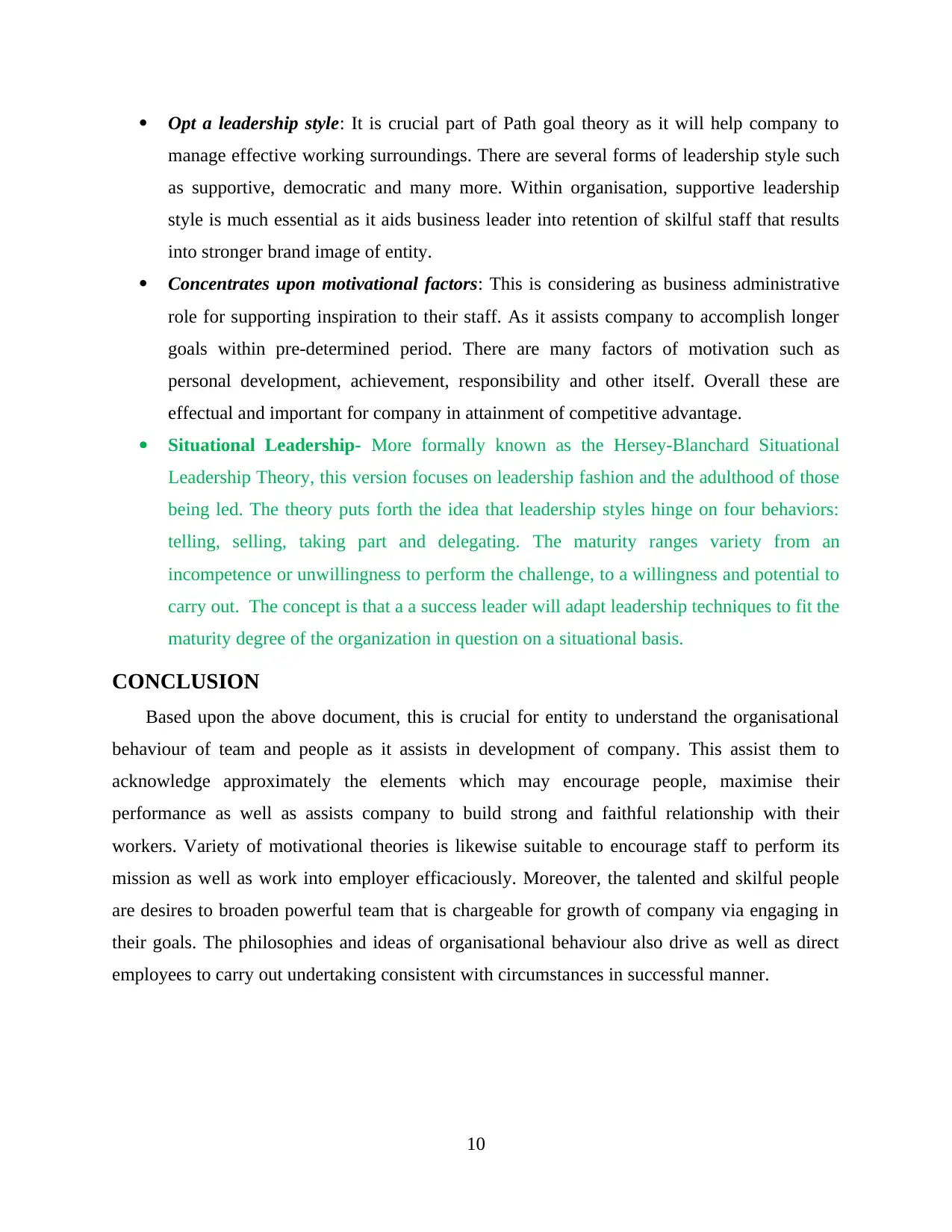
Opt a leadership style: It is crucial part of Path goal theory as it will help company to
manage effective working surroundings. There are several forms of leadership style such
as supportive, democratic and many more. Within organisation, supportive leadership
style is much essential as it aids business leader into retention of skilful staff that results
into stronger brand image of entity.
Concentrates upon motivational factors: This is considering as business administrative
role for supporting inspiration to their staff. As it assists company to accomplish longer
goals within pre-determined period. There are many factors of motivation such as
personal development, achievement, responsibility and other itself. Overall these are
effectual and important for company in attainment of competitive advantage.
Situational Leadership- More formally known as the Hersey-Blanchard Situational
Leadership Theory, this version focuses on leadership fashion and the adulthood of those
being led. The theory puts forth the idea that leadership styles hinge on four behaviors:
telling, selling, taking part and delegating. The maturity ranges variety from an
incompetence or unwillingness to perform the challenge, to a willingness and potential to
carry out. The concept is that a a success leader will adapt leadership techniques to fit the
maturity degree of the organization in question on a situational basis.
CONCLUSION
Based upon the above document, this is crucial for entity to understand the organisational
behaviour of team and people as it assists in development of company. This assist them to
acknowledge approximately the elements which may encourage people, maximise their
performance as well as assists company to build strong and faithful relationship with their
workers. Variety of motivational theories is likewise suitable to encourage staff to perform its
mission as well as work into employer efficaciously. Moreover, the talented and skilful people
are desires to broaden powerful team that is chargeable for growth of company via engaging in
their goals. The philosophies and ideas of organisational behaviour also drive as well as direct
employees to carry out undertaking consistent with circumstances in successful manner.
10
manage effective working surroundings. There are several forms of leadership style such
as supportive, democratic and many more. Within organisation, supportive leadership
style is much essential as it aids business leader into retention of skilful staff that results
into stronger brand image of entity.
Concentrates upon motivational factors: This is considering as business administrative
role for supporting inspiration to their staff. As it assists company to accomplish longer
goals within pre-determined period. There are many factors of motivation such as
personal development, achievement, responsibility and other itself. Overall these are
effectual and important for company in attainment of competitive advantage.
Situational Leadership- More formally known as the Hersey-Blanchard Situational
Leadership Theory, this version focuses on leadership fashion and the adulthood of those
being led. The theory puts forth the idea that leadership styles hinge on four behaviors:
telling, selling, taking part and delegating. The maturity ranges variety from an
incompetence or unwillingness to perform the challenge, to a willingness and potential to
carry out. The concept is that a a success leader will adapt leadership techniques to fit the
maturity degree of the organization in question on a situational basis.
CONCLUSION
Based upon the above document, this is crucial for entity to understand the organisational
behaviour of team and people as it assists in development of company. This assist them to
acknowledge approximately the elements which may encourage people, maximise their
performance as well as assists company to build strong and faithful relationship with their
workers. Variety of motivational theories is likewise suitable to encourage staff to perform its
mission as well as work into employer efficaciously. Moreover, the talented and skilful people
are desires to broaden powerful team that is chargeable for growth of company via engaging in
their goals. The philosophies and ideas of organisational behaviour also drive as well as direct
employees to carry out undertaking consistent with circumstances in successful manner.
10
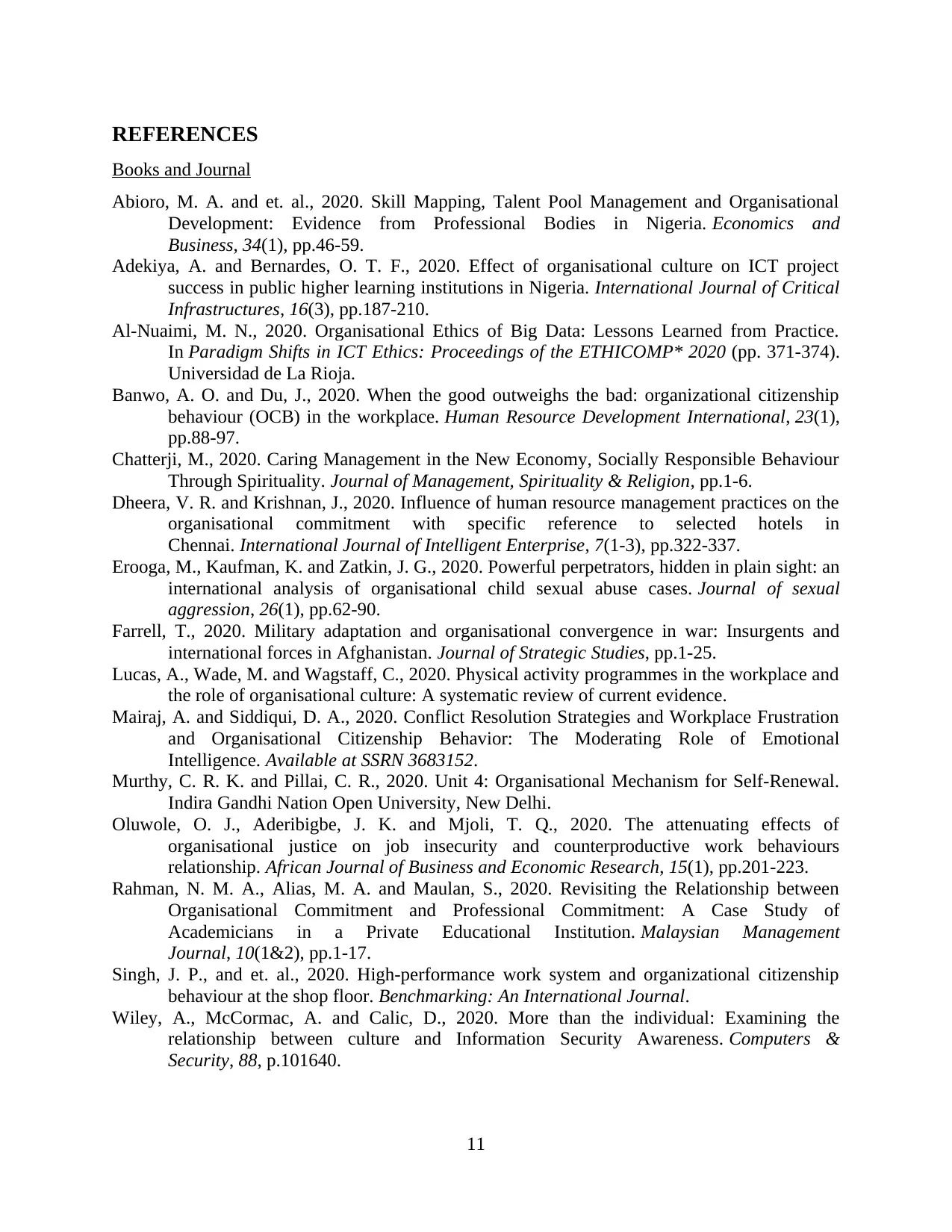
REFERENCES
Books and Journal
Abioro, M. A. and et. al., 2020. Skill Mapping, Talent Pool Management and Organisational
Development: Evidence from Professional Bodies in Nigeria. Economics and
Business, 34(1), pp.46-59.
Adekiya, A. and Bernardes, O. T. F., 2020. Effect of organisational culture on ICT project
success in public higher learning institutions in Nigeria. International Journal of Critical
Infrastructures, 16(3), pp.187-210.
Al-Nuaimi, M. N., 2020. Organisational Ethics of Big Data: Lessons Learned from Practice.
In Paradigm Shifts in ICT Ethics: Proceedings of the ETHICOMP* 2020 (pp. 371-374).
Universidad de La Rioja.
Banwo, A. O. and Du, J., 2020. When the good outweighs the bad: organizational citizenship
behaviour (OCB) in the workplace. Human Resource Development International, 23(1),
pp.88-97.
Chatterji, M., 2020. Caring Management in the New Economy, Socially Responsible Behaviour
Through Spirituality. Journal of Management, Spirituality & Religion, pp.1-6.
Dheera, V. R. and Krishnan, J., 2020. Influence of human resource management practices on the
organisational commitment with specific reference to selected hotels in
Chennai. International Journal of Intelligent Enterprise, 7(1-3), pp.322-337.
Erooga, M., Kaufman, K. and Zatkin, J. G., 2020. Powerful perpetrators, hidden in plain sight: an
international analysis of organisational child sexual abuse cases. Journal of sexual
aggression, 26(1), pp.62-90.
Farrell, T., 2020. Military adaptation and organisational convergence in war: Insurgents and
international forces in Afghanistan. Journal of Strategic Studies, pp.1-25.
Lucas, A., Wade, M. and Wagstaff, C., 2020. Physical activity programmes in the workplace and
the role of organisational culture: A systematic review of current evidence.
Mairaj, A. and Siddiqui, D. A., 2020. Conflict Resolution Strategies and Workplace Frustration
and Organisational Citizenship Behavior: The Moderating Role of Emotional
Intelligence. Available at SSRN 3683152.
Murthy, C. R. K. and Pillai, C. R., 2020. Unit 4: Organisational Mechanism for Self-Renewal.
Indira Gandhi Nation Open University, New Delhi.
Oluwole, O. J., Aderibigbe, J. K. and Mjoli, T. Q., 2020. The attenuating effects of
organisational justice on job insecurity and counterproductive work behaviours
relationship. African Journal of Business and Economic Research, 15(1), pp.201-223.
Rahman, N. M. A., Alias, M. A. and Maulan, S., 2020. Revisiting the Relationship between
Organisational Commitment and Professional Commitment: A Case Study of
Academicians in a Private Educational Institution. Malaysian Management
Journal, 10(1&2), pp.1-17.
Singh, J. P., and et. al., 2020. High-performance work system and organizational citizenship
behaviour at the shop floor. Benchmarking: An International Journal.
Wiley, A., McCormac, A. and Calic, D., 2020. More than the individual: Examining the
relationship between culture and Information Security Awareness. Computers &
Security, 88, p.101640.
11
Books and Journal
Abioro, M. A. and et. al., 2020. Skill Mapping, Talent Pool Management and Organisational
Development: Evidence from Professional Bodies in Nigeria. Economics and
Business, 34(1), pp.46-59.
Adekiya, A. and Bernardes, O. T. F., 2020. Effect of organisational culture on ICT project
success in public higher learning institutions in Nigeria. International Journal of Critical
Infrastructures, 16(3), pp.187-210.
Al-Nuaimi, M. N., 2020. Organisational Ethics of Big Data: Lessons Learned from Practice.
In Paradigm Shifts in ICT Ethics: Proceedings of the ETHICOMP* 2020 (pp. 371-374).
Universidad de La Rioja.
Banwo, A. O. and Du, J., 2020. When the good outweighs the bad: organizational citizenship
behaviour (OCB) in the workplace. Human Resource Development International, 23(1),
pp.88-97.
Chatterji, M., 2020. Caring Management in the New Economy, Socially Responsible Behaviour
Through Spirituality. Journal of Management, Spirituality & Religion, pp.1-6.
Dheera, V. R. and Krishnan, J., 2020. Influence of human resource management practices on the
organisational commitment with specific reference to selected hotels in
Chennai. International Journal of Intelligent Enterprise, 7(1-3), pp.322-337.
Erooga, M., Kaufman, K. and Zatkin, J. G., 2020. Powerful perpetrators, hidden in plain sight: an
international analysis of organisational child sexual abuse cases. Journal of sexual
aggression, 26(1), pp.62-90.
Farrell, T., 2020. Military adaptation and organisational convergence in war: Insurgents and
international forces in Afghanistan. Journal of Strategic Studies, pp.1-25.
Lucas, A., Wade, M. and Wagstaff, C., 2020. Physical activity programmes in the workplace and
the role of organisational culture: A systematic review of current evidence.
Mairaj, A. and Siddiqui, D. A., 2020. Conflict Resolution Strategies and Workplace Frustration
and Organisational Citizenship Behavior: The Moderating Role of Emotional
Intelligence. Available at SSRN 3683152.
Murthy, C. R. K. and Pillai, C. R., 2020. Unit 4: Organisational Mechanism for Self-Renewal.
Indira Gandhi Nation Open University, New Delhi.
Oluwole, O. J., Aderibigbe, J. K. and Mjoli, T. Q., 2020. The attenuating effects of
organisational justice on job insecurity and counterproductive work behaviours
relationship. African Journal of Business and Economic Research, 15(1), pp.201-223.
Rahman, N. M. A., Alias, M. A. and Maulan, S., 2020. Revisiting the Relationship between
Organisational Commitment and Professional Commitment: A Case Study of
Academicians in a Private Educational Institution. Malaysian Management
Journal, 10(1&2), pp.1-17.
Singh, J. P., and et. al., 2020. High-performance work system and organizational citizenship
behaviour at the shop floor. Benchmarking: An International Journal.
Wiley, A., McCormac, A. and Calic, D., 2020. More than the individual: Examining the
relationship between culture and Information Security Awareness. Computers &
Security, 88, p.101640.
11
Paraphrase This Document
Need a fresh take? Get an instant paraphrase of this document with our AI Paraphraser

12
1 out of 14
Related Documents
Your All-in-One AI-Powered Toolkit for Academic Success.
+13062052269
info@desklib.com
Available 24*7 on WhatsApp / Email
![[object Object]](/_next/static/media/star-bottom.7253800d.svg)
Unlock your academic potential
© 2024 | Zucol Services PVT LTD | All rights reserved.

